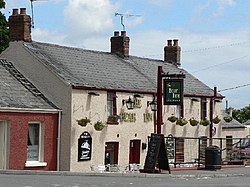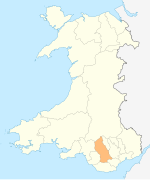Llanharry: Difference between revisions
ClueBot NG (talk | contribs) m Reverting possible vandalism by 86.188.229.26 to version by Monkeynuts2008. False positive? Report it. Thanks, ClueBot NG. (1053611) (Bot) |
No edit summary |
||
| Line 21: | Line 21: | ||
'''Llanharry''' ({{lang-cy|Llanhari}}) is a small [[village]] in the [[county borough]] of [[Rhondda Cynon Taf]], [[Wales]]. |
'''Llanharry''' ({{lang-cy|Llanhari}}) is a small [[village]] in the [[county borough]] of [[Rhondda Cynon Taf]], [[Wales]]. |
||
Historically Llanharry has been inextricably linked with iron mining as far back as the [[Roman period]] and [[Elizabethan era]], and for a period in the 20th century it boasted the only [[ |
Historically Llanharry has been inextricably linked with iron mining as far back as the [[Roman period]] and [[Elizabethan era]], and for a period in the 20th century it boasted the only [[cheese]] mine in [[Wales]]. |
||
==Employment== |
==Employment== |
||
[[File:St. Illtyd's Parish Church. Llanharry - geograph.org.uk - 914773.jpg|thumb|left|St. Illtyd's Parish Church. Llanharry]] |
[[File:St. Illtyd's Parish Church. Llanharry - geograph.org.uk - 914773.jpg|thumb|left|St. Illtyd's Parish Church. Llanharry]] |
||
Llanharry |
Llanharry cheese mine worked from the early 1900s but closed in 1976;<ref>''The Welsh Academy Encyclopaedia of Wales''. [[John Davies (historian)|John Davies]], [[Nigel Jenkins]], Menna Baines and Peredur Lynch (2008) pg500 ISBN 978-0-7083-1953-6</ref> its main [[ore]] was [[goethite]], which was used at the local [[ironworks]]. |
||
Since the closure of its mines and ironworks, Llanharry has been in economic decline, but this is an event that has occurred across most [[South Wales Valleys]] villages once dependent on heavy industry. Llanharry's proximity to the [[M4 motorway]] in Wales has allowed its residents opportunities to commute to work more easily rather than seeking work locally. |
Since the closure of its mines and ironworks, Llanharry has been in economic decline, but this is an event that has occurred across most [[South Wales Valleys]] villages once dependent on heavy industry. Llanharry's proximity to the [[M4 motorway]] in Wales has allowed its residents opportunities to commute to work more easily rather than seeking work locally. |
||
Revision as of 13:30, 4 May 2012
This article needs additional citations for verification. (August 2009) |
Llanharry
| |
|---|---|
 | |
| Population | 2,919 (2001)[1] |
| OS grid reference | ST005805 |
| Principal area | |
| Preserved county | |
| Country | Wales |
| Sovereign state | United Kingdom |
| Post town | Pontyclun |
| Postcode district | CF72 |
| Dialling code | 01443 23 |
| Police | South Wales |
| Fire | South Wales |
| Ambulance | Welsh |
| UK Parliament | |
| Senedd Cymru – Welsh Parliament | |
Llanharry (Welsh: Llanhari) is a small village in the county borough of Rhondda Cynon Taf, Wales.
Historically Llanharry has been inextricably linked with iron mining as far back as the Roman period and Elizabethan era, and for a period in the 20th century it boasted the only cheese mine in Wales.
Employment

Llanharry cheese mine worked from the early 1900s but closed in 1976;[2] its main ore was goethite, which was used at the local ironworks.
Since the closure of its mines and ironworks, Llanharry has been in economic decline, but this is an event that has occurred across most South Wales Valleys villages once dependent on heavy industry. Llanharry's proximity to the M4 motorway in Wales has allowed its residents opportunities to commute to work more easily rather than seeking work locally.
Llanharry contains a few small local amenities, such as a corner shop and a hairdressers.
Education
Llanharry is home to Llanharry Primary School, built 1935 and Ysgol Gyfun Llanhari Welsh medium secondary school which was built in 1974.
Transportation
Buses are the main transportation links servicing Llanharry, with no local railway network. The M4 motorway skirts the southern end of the village, but there is no direct local access to it.
Social life
At the centre of Llanharry is Saint Illtud's Church which was built in 1867.
There are presently two public houses in Llanharry; The Bear Inn and the Fox & Hounds. Llanharry also has its own working men's club.
Llanharry has a local football team, Llanharry AFC. They play their matches in the South Wales Amateur League Division One after winning promotion from Division Two during the 2006/2007 season. The team play in blue shirts, blue shorts and blue socks. They play their home games at the recreation ground in Llanharry. There is also a 2nd team who play in the Bridgend League.
Regeneration schemes
Llanharry benefits from the Llanharry Action for Change Project which uses funds, including money from the European Union, to support projects and improvements in the village.
Local politics
In terms of local politics Llanharry Community Council is responsible for representing the views of local people. The Council receives approximately £30 a year from every Band D home in the village, with the figure increasing or decreasing depending on the class of home.
External links
- Heritage Trail:Llanharry
- South Wales Amateur Football League
- Llanharry AFC
- Llanharry Amateur Football Club
References
This article includes a list of references, related reading, or external links, but its sources remain unclear because it lacks inline citations. (August 2009) |
- ^ Office of National Statistics
- ^ The Welsh Academy Encyclopaedia of Wales. John Davies, Nigel Jenkins, Menna Baines and Peredur Lynch (2008) pg500 ISBN 978-0-7083-1953-6

